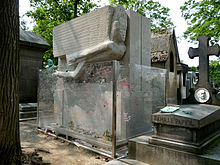
Hopton Wood stone (sometimes Hopton-Wood stone or Hoptonwood stone) is a type of limestone quarried west of Middleton-by-Wirksworth, Derbyshire, England. Described as "very fine, almost like marble" and as "England’s premier decorative stone", it is particularly suited to carving, making it popular for tombstones (including many thousands for the Commonwealth War Graves Commission), sculpture and building.
Buildings and structures made using Hopton Wood stone include the Houses of Parliament, Westminster Abbey, the Albert Memorial, Lichfield Cathedral, Calke Abbey, Chatsworth House and Oscar Wilde's tomb.
In 1947 the Hopton-Wood Stone Firms Ltd commissioned a book about Hopton Wood stone, published by Fanfare press.
References
- ^ "Bright Stone: Hopton Wood". British Geological Survey. Retrieved 2 May 2013.
- ^ "WIRKSWORTH Parish Records 1608–1899 – Hopton Stone". Retrieved 2 May 2013.
- ^ Thomas, Ian A. "Hopton Wood Stone – England's premier decorative stone" (PDF). England's Heritage in Stone Proceedings of a Conference Tempest Anderson Hall, York 15–17 March 2005: 90–105. Archived from the original (PDF) on 14 May 2014.
- ^ "Hopton Wood Limestone". Lowes Marble and Granite. Archived from the original on 15 September 2013. Retrieved 2 May 2013.
- Pennington, Michael (1987). An Angel for a Martyr. Whitenights Press. p. 32. ISBN 978-0704901131.
- "The Book". Retrieved 2 May 2013.